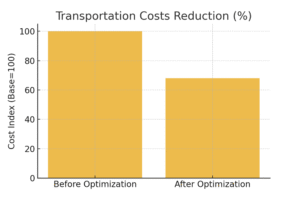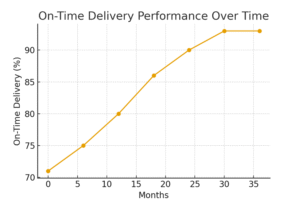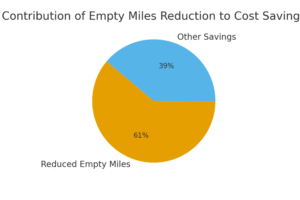Executive Summary
The global logistics sector is evolving rapidly under the influence of e-commerce expansion, volatile fuel prices, and stricter sustainability requirements. A leading multinational logistics company approached our consulting team to digitally transform its freight operations, aiming to reduce costs, increase visibility, and improve delivery performance.
By implementing AI-driven routing, predictive analytics, and real-time visibility platforms, the company achieved a 32% reduction in transportation costs, 22% improvement in on-time deliveries, and $280M in annualized savings.
Problem Statement
The client, a top-5 global logistics provider, faced several structural challenges:
-
Inefficient manual route planning causing frequent delays.
-
Escalating fuel costs with no centralized optimization.
-
Fragmented visibility across multiple geographies and modes (air, sea, road).
-
Low customer satisfaction due to inconsistent tracking updates.
The leadership realized that without a digital-first approach, the company risked losing contracts to more agile competitors and failing to meet sustainability commitments.
Approach & Methodology
Our team designed a 5-step freight optimization framework:
-
Diagnostic Assessment – Baseline analysis of route efficiency, fuel usage, and delivery performance.
-
AI-Driven Route Optimization – Machine learning algorithms suggested optimal routes considering cost, time, and sustainability.
-
Digital Freight Marketplace Integration – Connecting shippers with third-party carriers in real time.
-
Predictive Analytics – Demand forecasting for capacity planning and fuel hedging.
-
Customer Experience Enhancement – Real-time tracking dashboard integrated with CRM for proactive updates.
Solution & Implementation
-
Phase 1 (0–6 months): Piloted AI-driven routing in North America, achieving quick wins in fuel efficiency.
-
Phase 2 (6–18 months): Rolled out digital freight marketplace globally, reducing dependency on legacy brokers.
-
Phase 3 (18–30 months): Integrated predictive analytics into global planning, cutting demand-supply mismatches.
-
Phase 4 (30–36 months): Deployed unified customer dashboard across 40+ countries.
Results & Impact
| Metric | Before | After | Impact |
|---|---|---|---|
| Transportation Costs | Baseline | -32% | $280M savings |
| On-Time Delivery | 71% | 93% | +22% |
| Empty Miles | 18% | 7% | -61% |
| Customer Satisfaction (NPS) | 52 | 74 | +22 pts |
| CO₂ Emissions | Baseline | -19% | Sustainability gains |
– Transportation costs reduced by 32% within 24 months

– On-time delivery performance improved from 71% to 93%

– Empty miles reduced by 61%, contributing significantly to cost savings

Key Highlights:
-
AI-driven routing reduced empty miles by 61%.
-
Predictive analytics improved demand-supply balance.
-
Digital freight marketplace eliminated inefficiencies in carrier contracting.
Conclusion & Key Takeaways
This case demonstrates that digital freight optimization is a strategic imperative for logistics players. Companies that leverage AI, predictive analytics, and real-time platforms can significantly lower costs, boost service reliability, and strengthen customer relationships while meeting sustainability targets.